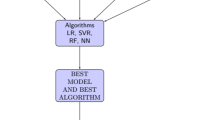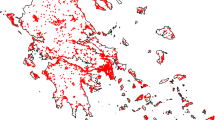Abstract
A method for enhancing property valuation models consists in determining zones of an urban municipality in which the prices of residential premises change similarly over time. Such similar zones are then merged into bigger areas embracing greater number of sales transactions which constitute a more reliable basis to construct accurate property valuation models. This is especially important when machine learning algorithms are employed do create prediction models. In this paper we present our further investigation of the method using the cadastral regions of a city as zones for merging. A series of evaluation experiments was conducted using real-world data comprising the records of sales and purchase transactions of residential premises accomplished in a Polish urban municipality. Six machine learning algorithms available in the WEKA data mining system were employed to generate property valuation models. The study showed that the prediction models created over the merged cadastral regions outperformed in terms of accuracy the models based on initial component regions.
Access this chapter
Tax calculation will be finalised at checkout
Purchases are for personal use only
Preview
Unable to display preview. Download preview PDF.
Similar content being viewed by others
References
Lasota, T., Sawiłow, E., Trawiński, B., Roman, M., Marczuk, P., Popowicz, P.: A method for merging similar zones to improve intelligent models for real estate appraisal. In: Nguyen, N.T., Trawiński, B., Kosala, R. (eds.) ACIIDS 2015. LNCS, vol. 9011, pp. 472–483. Springer, Heidelberg (2015)
Kontrimas, V., Verikas, A.: The mass appraisal of the real estate by computational intelligence. Applied Soft Computing 11(1), 443–448 (2011)
Zurada, J., Levitan, A.S., Guan, J.: A Comparison of Regression and Artificial Intelligence Methods in a Mass Appraisal Context. Journal of Real Estate Res. 33(3), 349–388 (2011)
Peterson, S., Flangan, A.B.: Neural Network Hedonic Pricing Models in Mass Real Estate Appraisal. Journal of Real Estate Research 31(2), 147–164 (2009)
Narula, S.C., Wellington, J.F., Lewis, S.A.: Valuating residential real estate using parametric programming. European Journal of Operational Research 217, 120–128 (2012)
Antipov, E.A., Pokryshevskaya, E.B.: Mass appraisal of residential apartments: An application of Random forest for valuation and a CART-based approach for model diagnostics. Expert Systems with Applications 39, 1772–1778 (2012)
D’Amato, M.: Comparing Rough Set Theory with Multiple Regression Analysis as Automated Valuation Methodologies. Int. Real Estate Review 10(2), 42–65 (2007)
Kusan, H., Aytekin, O., Özdemir, I.: The use of fuzzy logic in predicting house selling price. Expert Systems with Applications 37(3), 1808–1813 (2010)
Musa, A.G., Daramola, O., Owoloko, A., Olugbara, O.: A Neural-CBR System for Real Property Valuation. Journal of Emerging Trends in Computing and Information Sciences 4(8), 611–622 (2013)
Woźniak, M., Graña, M., Corchado, E.: A survey of multiple classifier systems as hybrid systems. Information Fusion 16, 3–17 (2014)
Krawczyk, B., Woźniak, M., Cyganek, B.: Clustering-based ensembles for one-class classification. Information Sciences 264, 182–195 (2014)
Burduk, R., Walkowiak, K.: Static classifier selection with interval weights of base classifiers. In: Nguyen, N.T., Trawiński, B., Kosala, R. (eds.) ACIIDS 2015. LNCS, vol. 9011, pp. 494–502. Springer, Heidelberg (2015)
Fernández, A., López, V.: José del Jesus, M., Herrera, F.: Revisiting Evolutionary Fuzzy Systems: Taxonomy, applications, new trends and challenges. Knowledge-Based Systems 80, 109–121 (2015)
Lughofer, E.: Evolving Fuzzy Systems – Methodologies, Advanced Concepts and Applications. STUDFUZZ, vol. 266. Springer, Heidelberg (2011)
Lughofer, E., Cernuda, C., Kindermann, S., Pratama, M.: Generalized smart evolving fuzzy systems. Evolving Systems (2015). doi:10.1007/s12530-015-9132-6
Król, D., Lasota, T., Nalepa, W., Trawiński, B.: Fuzzy system model to assist with real estate appraisals. In: Okuno, H.G., Ali, M. (eds.) IEA/AIE 2007. LNCS, vol. 4570, pp. 260–269. Springer, Heidelberg (2007)
Król, D., Lasota, T., Trawiński, B., Trawiński, K.: Comparison of mamdani and TSK fuzzy models for real estate appraisal. In: Apolloni, B., Howlett, R.J., Jain, L. (eds.) KES 2007, Part III. LNCS (LNAI), vol. 4694, pp. 1008–1015. Springer, Heidelberg (2007)
Lasota, T., Telec, Z., Trawiński, B., Trawiński, K.: Exploration of bagging ensembles comprising genetic fuzzy models to assist with real estate appraisals. In: Corchado, E., Yin, H. (eds.) IDEAL 2009. LNCS, vol. 5788, pp. 554–561. Springer, Heidelberg (2009)
Lasota, T., Telec, Z., Trawiński, B., Trawiński, K.: A multi-agent system to assist with real estate appraisals using bagging ensembles. In: Nguyen, N.T., Kowalczyk, R., Chen, S.-M. (eds.) ICCCI 2009. LNCS, vol. 5796, pp. 813–824. Springer, Heidelberg (2009)
Krzystanek, M., Lasota, T., Telec, Z., Trawiński, B.: Analysis of bagging ensembles of fuzzy models for premises valuation. In: Nguyen, N.T., Le, M.T., Świątek, J. (eds.) Intelligent Information and Database Systems. LNCS, vol. 5991, pp. 330–339. Springer, Heidelberg (2010)
Lasota, T., Telec, Z., Trawiński, G., Trawiński, B.: Empirical comparison of resampling methods using genetic fuzzy systems for a regression problem. In: Yin, H., Wang, W., Rayward-Smith, V. (eds.) IDEAL 2011. LNCS, vol. 6936, pp. 17–24. Springer, Heidelberg (2011)
Lasota, T., Telec, Z., Trawiński, B., Trawiński, K.: Investigation of the eTS Evolving Fuzzy Systems Applied to Real Estate Appraisal. Journal of Multiple-Valued Logic and Soft Computing 17(2–3), 229–253 (2011)
Lughofer, E., Trawiński, B., Trawiński, K., Kempa, O., Lasota, T.: On Employing Fuzzy Modeling Algorithms for the Valuation of Residential Premises. Information Sciences 181, 5123–5142 (2011)
Trawiński, B.: Evolutionary Fuzzy System Ensemble Approach to Model Real Estate Market based on Data Stream Exploration. Journal of Universal Computer Science 19(4), 539–562 (2013)
Telec, Z., Trawiński, B., Lasota, T., Trawiński, G.: Evaluation of neural network ensemble approach to predict from a data stream. In: Hwang, D., Jung, J.J., Nguyen, N.-T. (eds.) ICCCI 2014. LNCS, vol. 8733, pp. 472–482. Springer, Heidelberg (2014)
Witten, I.H., Frank, E., Hall, M.A.: Data Mining: Practical Machine Learning Tools and Techniques, 3rd edn. Morgan Kaufmann, San Francisco (2011)
Demšar, J.: Statistical comparisons of classifiers over multiple data sets. J. of Machine Learning Research 7, 1–30 (2006)
Trawiński, B., Smętek, M., Telec, Z., Lasota, T.: Nonparametric Statistical Analysis for Multiple Comparison of Machine Learning Regression Algorithms. International Journal of Applied Mathematics and Computer Science 22(4), 867–881 (2012)
García, S., Herrera, F.: An Extension on “Statistical Comparisons of Classifiers over Multiple Data Sets” for all Pairwise Comparisons. Journal of Machine Learning Research 9, 2677–2694 (2008)
Author information
Authors and Affiliations
Corresponding author
Editor information
Editors and Affiliations
Rights and permissions
Copyright information
© 2015 Springer International Publishing Switzerland
About this paper
Cite this paper
Lasota, T. et al. (2015). Enhancing Intelligent Property Valuation Models by Merging Similar Cadastral Regions of a Municipality. In: Núñez, M., Nguyen, N., Camacho, D., Trawiński, B. (eds) Computational Collective Intelligence. Lecture Notes in Computer Science(), vol 9330. Springer, Cham. https://doi.org/10.1007/978-3-319-24306-1_55
Download citation
DOI: https://doi.org/10.1007/978-3-319-24306-1_55
Published:
Publisher Name: Springer, Cham
Print ISBN: 978-3-319-24305-4
Online ISBN: 978-3-319-24306-1
eBook Packages: Computer ScienceComputer Science (R0)




